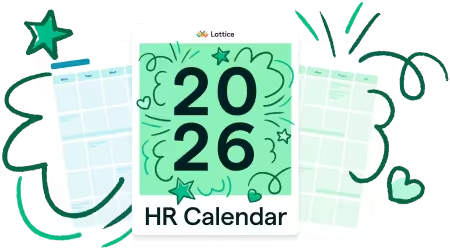Employee Breaks Policy Template


Download this template for free
By submitting your information, you agree to Lattice's Terms of Service and Privacy Policy. You can opt out anytime.
Thanks! We'll be in touch soon.
Breaks may seem like small moments in the workday, but they play a big role in employee health, focus, and productivity. Providing clear and consistent guidelines for meal and rest breaks helps your team recharge — while keeping your company compliant with federal, state, and local labor laws.
A break policy outlines when employees are entitled to time away from work, how long those breaks should be, and how they’re tracked. This helps avoid confusion, ensures fair treatment, and creates a healthier, more sustainable work environment for everyone.
What the Employee Breaks Policy Should Include
To be effective, your break policy should clearly cover:
- Purpose and scope: Who the policy applies to and why it exists.
- Types of breaks: Rest breaks, meal breaks, and any additional paid or unpaid breaks.
- Eligibility: Break guidelines by role, schedule, or employment classification.
- Length and timing: How long breaks should be and when they should occur during a shift.
- State or local compliance: Where break laws vary by location.
- Tracking and timekeeping: Expectations for logging and monitoring breaks.
- Non-interruption of breaks: Guidelines for ensuring breaks are truly restful and uninterrupted.
- Overtime impact: Clarification on how breaks do (or do not) affect overtime calculations.
- Manager and employee responsibilities: Who ensures breaks are taken and recorded properly.
Purpose of the Employee Breaks Policy
The purpose of this policy is to:
- Ensure employees have regular opportunities to rest, eat, and recharge during the workday.
- Provide a consistent framework for break eligibility and scheduling.
- Comply with all applicable labor laws regarding paid and unpaid break time.
- Support employee wellness, focus, and retention by encouraging work-life balance throughout the day.
This policy is part of [Company Name]’s broader commitment to fostering a healthy and sustainable work environment.
Sample Employee Breaks Policy
{{rich-highlight-1}}
Effective Date: [Insert Date]
Policy Owner: People Team / HR Department
Last Reviewed: [Insert Date]
1. Policy Overview
[Company Name] supports the physical, mental, and emotional well-being of employees by providing regular rest and meal breaks throughout the workday. This policy outlines our approach to breaks, including timing, duration, and applicable legal requirements.
This policy applies to all nonexempt (hourly) employees. Exempt (salaried) employees are also encouraged to take regular breaks, but are not subject to timekeeping requirements under the Fair Labor Standards Act (FLSA).
2. Rest Breaks (Paid)
Employees are entitled to a paid rest break of 10 to 15 minutes for every 4 hours of work. These breaks are:
- Paid: Employees are not required to clock out.
- Flexible: Breaks may be scheduled at a convenient time, subject to manager approval and business needs.
- Uninterrupted: Employees should be free from work responsibilities during rest breaks.
Employees working fewer than 4 hours may not be entitled to a rest break under federal or state law, but we encourage all employees to step away from work when needed.
3. Meal Breaks (Unpaid)
Employees who work more than 5 consecutive hours are entitled to an unpaid meal break of at least 30 minutes. Guidelines include:
- Unpaid: Employees must clock out for their meal break unless they are required to remain on duty.
- Uninterrupted: Meal breaks must be duty-free. Employees should not perform work tasks, answer emails, or take calls.
- Timing: Meal breaks should be taken no later than the end of the fifth hour of work unless otherwise approved.
- Additional meal breaks may be required if an employee works more than 10 hours in a day (varies by state).
4. Compliance by Location
Break requirements may differ by state or locality. [Company Name] complies with all applicable state and local regulations, including:
- California: Requires both a 10-minute rest break for every 4 hours worked and a 30-minute unpaid meal break for shifts over 5 hours.
- New York: Provides meal breaks for employees who work more than 6 hours between 11 a.m. and 2 p.m.
- Oregon, Colorado, Washington, and other states may have additional requirements.
If your location has specific break entitlements, they will be communicated during onboarding or can be confirmed with your People Partner.
5. Breaks and Timekeeping
Hourly (nonexempt) employees must:
- Clock out for unpaid meal breaks
- Remain clocked in during paid rest breaks
- Accurately record all working time in the company’s timekeeping system
Tampering with time records or failing to take mandated breaks may result in corrective action.
{{rich-highlight-3}}
6. Workload and Scheduling
Managers are responsible for:
- Ensuring employees have adequate time for legally required breaks
- Scheduling shifts to accommodate uninterrupted rest and meal periods
- Avoiding excessive workloads or back-to-back meetings that interfere with breaks
Employees should communicate with their managers if they are consistently unable to take scheduled breaks due to workload.
7. Exempt Employees
While this policy primarily applies to nonexempt employees, [Company Name] encourages exempt employees to take breaks throughout the day to maintain focus and well-being.
Exempt team members are not required to log rest or meal periods but are expected to maintain a sustainable and professional work rhythm.
8. Missed Breaks
Employees who are unable to take a required break — whether due to operational needs or scheduling issues — should notify their manager or HR as soon as possible.
[Company Name] will investigate and take corrective action as needed. Employees will not be penalized for reporting missed breaks in good faith.
Frequently Asked Questions
1. Do I need to clock out for every break?
Only for unpaid meal breaks. Paid 10- to 15-minute rest breaks should be taken while clocked in.
2. Can I combine breaks into one longer break?
No. Breaks are intended to be spaced throughout the day to support regular rest and focus. Combining breaks or taking them at the start/end of a shift is not permitted unless approved in advance.
3. What if I’m too busy to take a break?
Breaks are a legal right and a business priority. Talk to your manager if your schedule consistently interferes with your ability to step away. We want to help you make time to recharge.
4. Do salaried (exempt) employees have the same break rights?
Exempt employees are not subject to the same labor laws as hourly workers, but we strongly encourage everyone to take regular rest and lunch breaks.
5. What happens if I miss a meal break?
Let your manager or HR know. Depending on your location, you may be entitled to a break penalty or retroactive adjustment.
{{rich-highlight-2}}
🚩 Please note: This sample policy is for informational purposes only and does not constitute legal advice. It is a generic template that may not suit your specific circumstances. When adopting or revising a policy, consult legal counsel to ensure compliance with all applicable laws and regulations.
✨ Disclaimer: This resource was developed with the help of artificial intelligence, though reviewed, edited, and approved by (real) humans.
Frequently Asked Questions

Your people are your business
Ensure both are successful with Lattice.





.webp)